Intro
This article brings together several aspects of customs and daily life in the Middle Ages. We will study successively:
- Urban life in the Middle Ages, with the expansion of the communes and the description of Paris
- Peasant life in the countryside
- Popular entertainment such as fairs or knight's tournaments
- Mores and customs, dress, hairstyles, role of women...
Urban life
Communities
With the economic awakening and the growth of cities, the influence of its inhabitants, the burgenses or bourgeois was growing. In the principal cities of Europe were formed associations called corporations, guilds or hanses, and bringing together people exercising the same profession. At first their role consisted of mutual support against competition and need. But the corporations very quickly came up against the lords who took a dim view of this organization which was foreign to the feudal order. The struggle between lords and bourgeois was thus at the origin of the movement of free communes. Little by little, the prosperity and the unity of the town bourgeoisie succeeded in controlling or neutralizing the effective power of the lord. The means used were diverse. Sometimes the citizens found the support of a precious ally:the bishop of the city. The bishop did not hesitate to defend the bourgeois against their lord and even to take up arms to oppose the great feudal lords. In other places, it was the sovereign himself who supported the claims of the bourgeois:the count of Flanders and the king of France encouraged the movement of the communes. For the King of France, it was a question of weakening the power of the great feudatories of the kingdom. Thus, the citizens of a city "governed themselves in common", hence the name of commune.
Communal freedoms
In most cases, the conspiring bourgeois bought their freedoms from the lord. If the lord accepted, “charters of franchise” (or freedom) were drawn up, listing the rights granted to free communes. But very often, irritated by the refusals and reluctance they encountered, the townspeople did not hesitate to resort to violence. Of course, feudal repression was terribly bloody (1076:Le Mans, 1114:Amiens...). But the movement spread during the 12th and 13th centuries. The freedoms acquired by the cities were more or less extensive. In the northeast of France, the town enjoys real independence. It makes its laws, beats its currency, raises a militia... But it is in Germany and Northern Italy that the freedoms are the widest:the municipalities constitute real small states. Having obtained their autonomy, the communes organized themselves under the government of their magistrates, controlled and aided by the communal council, which included the richest and most influential figures in the city. Often, conflicts broke out between the corporations and the greats of the city (merchants, bankers...). The king then proposed his arbitration in the face of these permanent conflicts. But sometimes, the city appealed to a character foreign to the city, the podesta (one who exercises authority), to whom the government of the city was entrusted. The emancipation movement in these cities introduced ways of thinking and attitudes that were foreign to the feudal world. Finally, he bequeathed an institution that has survived to this day:the municipal system.
"The air of the city makes you free"
A special rule was established in certain municipalities, notably Bologna. It consisted in buying the freedom of a slave if he took refuge for a year and a day in a commune. The citizens wanted no serfs or slaves in their territory.

Paris in the Middle Ages
Protected by the thick wall of its ramparts, which disciplined its growth and sheltered it from invasions, Paris, at the end of the 13th century, had around 200,000 inhabitants, which was enormous for the time. Located on the Sainte-Geneviève mountain, the university attracts more than two thousand students and a hundred professors from all over Europe. In this district, merchants and artisans are mainly specialized in books (binders, parchment makers, illuminators). Between this intellectual quarter on the left bank and the market town on the right bank, the Ile de la Cité concentrates political and religious functions. Robert the Pious, at the beginning of the 11th century, decided to establish the royal residence there. From 1160, under the impulse of Sully, bishop of Paris, the site of a new cathedral was opened. The bishop directs the work himself, hiring tailors, carpenters... Thanks to the application of the principles of ogival (or Gothic) architecture, Notre-Dame can raise its vault up to 35 meters, and its walls pierced with multicolored stained glass, allow light to penetrate the nave to illuminate the many statues. In 1245, Saint Louis built the Sainte-Chapelle, a monument of exceptional architectural audacity. 1130 glass panels summarize the history of the world as it is told in the Bible. Located at the crossroads of a waterway, the Seine, and the land route from Orléans to Senlis, Paris is also an important commercial crossroads and a major economic and banking centre. The Seine is crowded with boats and its banks are dotted with mills. On the right bank, two large buildings built by Philippe Auguste allow the protection of stored goods. As a result of the development of the city, this first permanent market (the first halls) quickly overflowed the planned enclosure. Workshops and stalls then invade the streets. The craftsmen gather by streets to which they give the name of their corporation:rue de la Ferronnerie, rue de la Tissanderie... The most important corporation is that of the "water merchants", its leader, will eventually impose himself as Mayor of Paris.
Paris in the Middle Ages
- On the left, the market town, the liveliest (right bank).
- In the center, on the island, we have the religious and political functions
- On the right, the intellectual quarter of the city, with its university and craftsmen specializing in books (left bank).

Very busy streets
In 1131, the eldest son of Louis VI who was riding in Paris was thrown from his mount which had been frightened by a herd of pigs. The dolphin fractured his skull and died soon after. The king had therefore banned pigs in the city. But the animals did not disappear. The squares and streets were very dirty, until the day when Philippe Auguste, bothered by the smell of manure which rose to his windows, decided to have them paved. These streets were the scene of immense activity. From daybreak, the steamer invited citizens to take a hot bath in his establishment. The shops opened then:drapers, barbers called out to customers from the doorsteps, the pastry chef offered his cakes, his sausages and his pâté. Bread was sold by street vendors, who carried it in large wicker baskets. As people could not read, traders displayed heavy signs on their shop. But it wasn't just the merchandise that was being touted on the street. Official acts and news were shouted. Crowds of onlookers formed around jugglers, musicians who notably recited songs of gesture. Mixed in with the crowd, the beggars implored the passers-by. Sewage and rubbish were thrown out the windows, “Watch out for the water! they shouted. When night fell, the streets were plunged into darkness, there was still no public lighting. Also, at night, the streets were abandoned to brigands.
Rural life
Countryside and city
The peasants represent nearly 95% of the medieval population, they formed the material base, and the foundation of the economic activity of European civilization. The dynamism of the merchants and craftsmen made the prosperity of the cities, but it was the peasants who fed the townspeople. The work of the ground was difficult and laborious, but it improved, and allowed Europe to prosper. In the Middle Ages, the separation between city and countryside was less clear than today. Around the ramparts of the city stretched fields and meadows. But the technical development with the growth of trade, crafts and intellectual work in the city, and culture and breeding in the countryside, led to a more marked separation. The life of the peasants married the rhythm of the seasons, the same work was repeated from one year to another. Transformations in the countryside were less numerous and slower than in town. City life, on the contrary, favored contact between individuals, the dissemination of technical and intellectual knowledge. The city dweller seemed less subject to the constraints of nature.
The representation of time
In the Middle Ages, the peasants had a conception of time very different from ours; they imagined it as something that repeated itself endlessly and always returned to its starting point, like the hands of a clock. Time was for them like the seasons which followed one another. Thus the farmers' calendar closely followed the succession of agricultural activities (ploughing, sowing, harvesting, etc.). The months of the year are a motif frequently represented in the Middle Ages, each month is symbolized by the agricultural activities of the season.
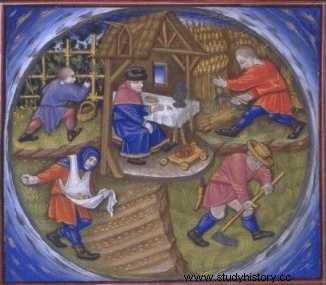
Two categories of peasants
- The serfs of the soil :The peasants, or serfs of the glebe (that is to say of the land, in the sense of cultivated soil) were part of the domain. When the land was sold, they passed from one master to another, in the same way as farm animals. The sons of peasants became peasants like their ancestors, and like their future descendants. But serfdom was not strictly speaking slavery, even if the condition of serfs was close to the slaves of antiquity. From the end of the Roman Empire, slavery had declined under the influence of the new economic and social organization, which had been formed around the domain, and which supplemented the state in full decomposition. Moreover, the Church condemned slavery. The serfs had many obligations but also rights. They were fully considered people, and theoretically they could leave the estate at any time, no law requiring them to remain tied to the land.
- Manants and alleutiers :The phenomenon of serfdom became widespread in Northern Europe. The many European terms testify to this. From Latin manere (resider), derived the words mansus or manse, that is to say the fields and the house of the peasants. In French, the peasant was called manant , the one who stays on the earth. The dwelling on the farm was called a house. In England, the lords called manor , manor, the small castle intended to monitor and protect the fields. Alongside the serfs there remained free peasants or alleux . The alleutiers (or vilains), as they were called in France, were very numerous in southern Europe.
Glebe serfs working the fodder crop
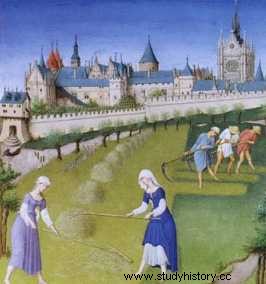
Introduction of fodder crops (16th century)
The distribution of the territory
At the beginning of the Middle Ages, Europe was an uncultivated and wild expanse, impoverished by the passage of barbarian tribes. The transformation of this continent is the result of the uninterrupted work begun in medieval times, and in particular of the great clearing of the forests (by fire or the axe). The land belonging to the lord was divided into two parts:
- The state reserve :From Latin dominus (master). In addition to the castle or the seigneurial residence, it included fields, vineyards, pastures, forests, the lord's hunting ground. It also included the village settled around the castle, with the oven, the mill and craftsmen such as the saddler or the blacksmith.
- Manses :The rest of the estate was divided into manses (or tenures) allocated according to their extent to one or more peasant families. The manse was the fundamental cell of the agrarian economy of the Middle Ages. The serf had the produce of the vegetable garden, as well as the barnyard and pork, one of the only sources of animal protein, the sheep was reserved for wool and the beef for the draft. The serf also had the right to graze his animals on fallow fields (uncultivated land).
The evolution of serfdom
In exchange for land and military protection, the serf had some duties to his lord. He had to hand over part of the harvest to his overlord and pay taxes. He also had to participate free of charge in work called corvées. These tasks could be plowing, harvesting or weeding on the lands of the lord. But they were also called upon to repair a bridge, dig a well or repair the walls of the castle. But over the years, the money needs of the lords increased, partly because of general enrichment. The peasant as for him obtained income by selling to the market the products which he did not consume. This changed the condition of the serf who could thus free himself from chores and military requisitions in exchange for a sum of money to the lord. We thus passed from serfdom to tenant farming, the owner renting the land to the peasant who exploited it on his own account. Agricultural production increased considerably because the peasant was self-employed and had to obtain enough to pay the rent and to feed his family.
Peasants plowing a field
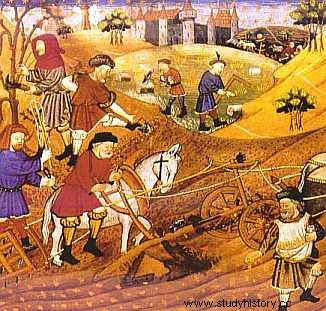
New farming techniques
The peasants had observed that certain crops such as cereals impoverished the soil, while others such as legumes (peas, broad beans, beans) enriched it. To avoid the exhaustion of the soil, the farmers of Antiquity had instituted the biennial rotation system:a field sown in cereals was left fallow the following year, it was plowed, but not sown, and served as pasture. In the Middle Ages, the rotation became three-year:the field was cultivated in cereals the first year, then in vegetables the second year, before being left fallow the third year. The gain of this system was twofold. Indeed, now only one out of three fields remained unproductive, and the cultivation of vegetables enriched the land. Production increased by 50%, the peasant could sell his surpluses and improve his precarious condition. In addition, the technique allowed the improvement of agricultural tools:plow, plough, harrow, hoe, sickle...
Popular entertainment
Fairs and shows
- Fairs :It was from the 9th century and under the rise of the crusades that a religious fervor gave new vigor to social life. The great European fairs of the Middle Ages had their first moment of authentic splendor at this time. The fairs appeared as the consequence of the need for traders to stock up on goods of all kinds. France was a key player in the development of the great medieval fairs, among which stand out those of Champagne and the Parisian fair of Lendit. In the 12th century appeared other fairs and other products, notably the fair of Beaucaire in Languedoc. But over time, the southern French fairs were eclipsed by those organized four times a year, for two weeks, in the city of Lyon, since 1420. The privileged location of Lyon, at a crossroads where flows of international traffic from of the four cardinal points, made it a city of fairs par excellence.
- Shows :The Late Middle Ages was a time when industry and trade had a boom that will only be exceeded at the dawn of the Industrial Revolution of the 18th century. People then moved everywhere, on sea as on land. Traveling shows took place from fair to fair and in the most modest regional markets. Acrobats, tightrope walkers, knife throwers, ventriloquists, storytellers, jesters, clowns, mimes... passed from palace to castle, without neglecting the smallest royal courts. Sometimes authentic theatrical works were staged. The works represented by these traveling companies were rudimentary, as few people could read and write. The dialogues could thus be delivered to the improvisation of the interpreters, who could be students on vacation or religious.
Merchant Fair

Tournaments
Only knights could participate in jousts and tournaments. These competitions were the most popular spectacle for the public throughout the Middle Ages. The tournament was solemnly opened by a herald (officer in charge of making solemn proclamations), who announced in the public squares the intention of the king or a great lord to gather for this celebration the most famous knights of the country. Around a vast esplanade, called lice , the participants had erected their rich tents or pavilions. At the top of the lance planted at the entrance hung the shield with the coat of arms of the lord. The tournament usually lasted several days. The events were varied and endowed with a rich prize. The adversaries clashed with so-called "courteous" weapons, that is to say, made harmless or almost (accidents were frequent):the spears were blunted and the swords deprived of their edge. While the joust saw two horsemen confront each other separated by a barrier or a rope, the "melee" consisted of a real pitched battle between two groups of horsemen equal in number. The scrum took place in an open field, and although there were a few rules such as not to strike, it was very violent! It was not uncommon to get the dead out of the battlefield. In the 15th century, companies of knights were formed whose sole purpose was to promote tournaments. For young younger sons of aristocrats, the tournament became a real profession. According to the chroniclers, the fighting became more and more spectacular. There were sometimes other competitions such as freestyle wrestling, archery, crossbow or slingshot.
The game
The most spectacular test was the joust, during which two adversaries confronted each other directly, on foot and on horseback. The knight defied his rival by touching the point of his sword to the shield hanging from his pavilion. The challenge then had to be met. Descended into the lists, the knight adorned his resplendent armour, manifesting his feelings towards his lady, to whom the fight was dedicated:the knight wore on his arm, on the spear, or around his neck, a veil or a handkerchief in the colors of it. Then the game began. At the signal of the judges, the competitors dashed off at a gallop one against the other; the clash of spears against shields or armor was terrible. If neither of the two adversaries was unhorsed, a new engagement succeeded the first. On the contrary, if one fell, the other dismounted and the duel continued with sword or mace. The loser had to honestly acknowledge his defeat, otherwise the judges declared him "hors de combat". The winner received not only the prize in competition, but also the weapons, the horses and the very person of the loser:the latter was considered a prisoner and regained freedom under a ransom.
The Last Tournament
In 1559, it was during a double marriage that a spectacle of very disastrous memory took place. To close the festivities, a tournament took place in Paris. The King of France Henry II then decided to participate in it to face the Count of Montgomery, one of the finest blades of the time. Fate caused that during the third pass, Montgomery's spear, deflected by Henry's shield, penetrated under the visor of his helmet and crossed his eye. The king agonized for ten days, then died. Queen Catherine de Medici then banned tournaments and jousts on French soil.
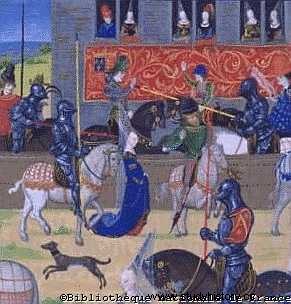
Parties
In the Middle Ages, nearly one day out of three was non-working, there were a lot of vacations. The majority of celebrations are Catholic, but tradition has preserved some rites of pagan origin:
- Catholic holidays
- Epiphany:It corresponds to the presentation of Jesus to the Magi. The traditional galette des rois is then shared.
- Lent:Forty days before Easter, the people are invited to share, fast and pray.
- Easter:Around the beginning of spring, painted eggs are exchanged to symbolize the end of the hardships of winter and Lent.
- Toussaint:Festival of Celtic origin, instituted by Louis the Pious. On November 1, we celebrate All Saints, that is to say of the Community of the living and the dead.
- Christmas:On December 25, we celebrate the advent of Christ.
- Secular celebrations
- The Feast of Fools:It was celebrated on Christmas Day, New Year's Day or even Epiphany. Servants took the place of their masters, established values of society were overturned, and religion was ridiculed.
- The Donkey Festival:It was celebrated in some towns on Christmas Eve. In memory of the flight to Egypt, a young girl holding a child in her arms entered a church on the back of a donkey. During the mass, all the prayers then ended with "hi-han". The Church quickly banned these celebrations.
- The Buts:On May 1 or during the month of May, young men placed tree branches in front of the doors of young girls to be married. The tree branch symbolized the girl's good or bad qualities.
- La Saint-Jean:On the evening of June 24, at harvest time, big fires are lit. Young couples held hands and jumped over the fire to have children or a good harvest.
- Saint-Michel:On September 29, the peasants had to pay the lords their dues (taxes).
Mores and customs
The status of women
In the Middle Ages, the Church considered women as the instigators of original sin, they were suspected of carrying heresy. There is only one remedy for this:marriage, by making the woman a mother. It is the families that unite their children, generally twelve years old for women and fourteen years old for men. In the higher classes, marriage is an instrument of alliances and implementations. If the couple is unable to have a child, the marriage may be challenged, and the woman may be repudiated. Many pregnancies are fatal to the mothers, and in the absence of abortion infanticide is practiced a great deal. Prostitutes or prostitutes are very present in the Middle Ages. Prostitution is authorized by the Church, the woman must come from a foreign city to avoid incest. Often, these women have been rejected by their families after a rape or a clandestine pregnancy. Rape is punished, but not in the same way:if it is a nun, a married woman or a virgin, the crime can be punished by death. If it is a servant of humble condition, an indemnity must be provided to the family. Women participate actively in economic life, moreover, in the food trade, women are in the majority. However, wages are from this time much lower than for men. In the countryside, they help their husbands with agricultural tasks. But through the courtly love of knights and troubadours, women remain an important source of inspiration. Mainly developed by the Occitan culture, women are revered for their beauty and love, men for their courage and bravery. Finally, some women have succeeded in forging a solid historical reputation:Eleanor of Aquitaine, Marie de France, Joan of Arc...
Costumes and clothing
Clothing has a social significance in the Middle Ages:depending on the rank and the functions occupied, we will not dress in the same way. In the 15th century, most men adopted the wearing of a very short outer garment, but some, out of decency, continued to wear long robes and coats:priests, notables, scholars. Among these, doctors and lawyers share the privilege of wearing the same red suit lined with white fur. The clothes themselves are complemented by numerous costume accessories. The belt, usually a simple leather strap, is sometimes studded. That of women can be goldsmithed and constitute a real jewel. Many men hang a purse or satchel on their belt. Essential accessory of the costume, the aiguillettes are laces hanging one to the other two garments or two pieces of the same garment.
Cycle of the Passion of Christ:Denial of Saint Peter
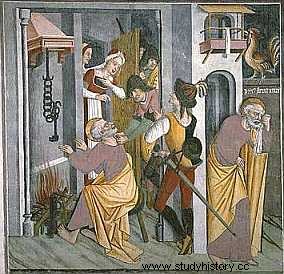
Cycle of the Passion of Christ:Denial of Saint Peter (10/25) - Notre-Dame des Fontaines Sanctuary, La Brigue
Hairstyles
The people of the Middle Ages do not conceive of living bareheaded, the variety of headgear, both male and female, is flagrant. Higher-ranking women wear horned headdresses completely concealing their pulled-back hair. These headdresses are covered with fashioned fabric and sometimes with a fishnet. Some wear a simple white veil falling over their shoulders. When they are old, the women wrap their whole head, including the chin, in white cloths called touailles. The touaille is a narrow and very elongated piece of fabric that is part of the bride's trousseau and is used for everything in the house:tea towel, napkin, hand towel, swimsuit, bandage, apron... Diversity and hierarchy also appear in the male hairstyles. Manual workers and laborers wear a simple cap. Getting your hood ready requires a certain dexterity:this long piece of cloth is rolled up at the top of the head. One, short, falls on the side, the other longer, flexibly drapes the shoulders; in case of bad weather it can also tighten the neck and ears more to protect them from the cold.
Meals
The table is usually covered with a white tablecloth, in the center of the table in a large standing cup is the main course. The food is not placed on plates but on "abacuses", large slices of loaves of bread, which absorb the juice. Other rolls, shaped into balls detachable from each other, are available to the guests. People eat with their fingers and share a few glasses and a few knives, the spoon is reserved for the service of the central dish, the fork does not exist at this time (introduced under Henri III). The food is minced (we have bad teeth) and very spicy (it doesn't keep well). Decanters, for water and for wine, and different kinds of jugs and pitchers are used in every home.
Cycle of the Passion of Christ:Last Supper
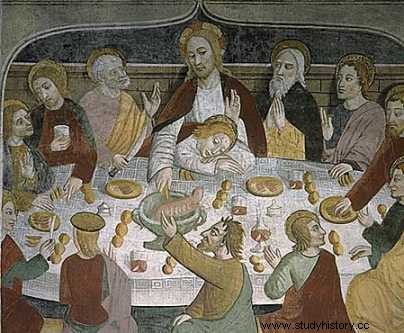
Cycle of the Passion of Christ:Last Supper (2/25) - Sanctuary of Our Lady of the Fountains, La Brigue
